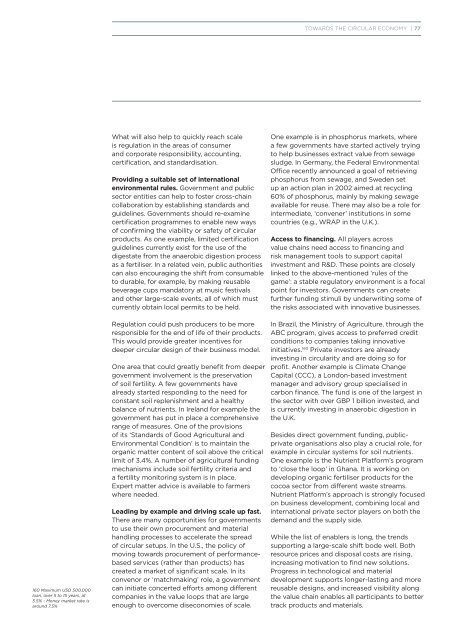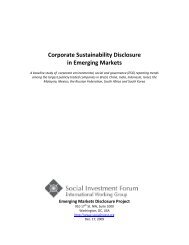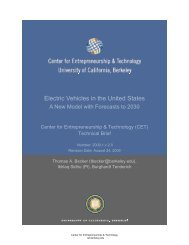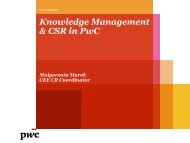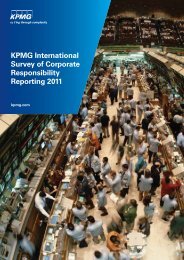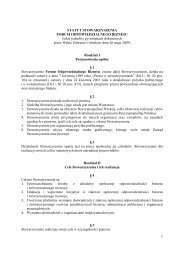The Circular Economy - 2013 Report - State of Texas Alliance for ...
The Circular Economy - 2013 Report - State of Texas Alliance for ...
The Circular Economy - 2013 Report - State of Texas Alliance for ...
Create successful ePaper yourself
Turn your PDF publications into a flip-book with our unique Google optimized e-Paper software.
TOWARDS THE CIRCULAR ECONOMY | 77<br />
160 Maximum USD 500,000<br />
loan, over 5 to 15 years, at<br />
5.5% - Money market rate is<br />
around 7.5%<br />
What will also help to quickly reach scale<br />
is regulation in the areas <strong>of</strong> consumer<br />
and corporate responsibility, accounting,<br />
certification, and standardisation.<br />
Providing a suitable set <strong>of</strong> international<br />
environmental rules. Government and public<br />
sector entities can help to foster cross-chain<br />
collaboration by establishing standards and<br />
guidelines. Governments should re-examine<br />
certification programmes to enable new ways<br />
<strong>of</strong> confirming the viability or safety <strong>of</strong> circular<br />
products. As one example, limited certification<br />
guidelines currently exist <strong>for</strong> the use <strong>of</strong> the<br />
digestate from the anaerobic digestion process<br />
as a fertiliser. In a related vein, public authorities<br />
can also encouraging the shift from consumable<br />
to durable, <strong>for</strong> example, by making reusable<br />
beverage cups mandatory at music festivals<br />
and other large-scale events, all <strong>of</strong> which must<br />
currently obtain local permits to be held.<br />
Regulation could push producers to be more<br />
responsible <strong>for</strong> the end <strong>of</strong> life <strong>of</strong> their products.<br />
This would provide greater incentives <strong>for</strong><br />
deeper circular design <strong>of</strong> their business model.<br />
One area that could greatly benefit from deeper<br />
government involvement is the preservation<br />
<strong>of</strong> soil fertility. A few governments have<br />
already started responding to the need <strong>for</strong><br />
constant soil replenishment and a healthy<br />
balance <strong>of</strong> nutrients. In Ireland <strong>for</strong> example the<br />
government has put in place a comprehensive<br />
range <strong>of</strong> measures. One <strong>of</strong> the provisions<br />
<strong>of</strong> its ‘Standards <strong>of</strong> Good Agricultural and<br />
Environmental Condition’ is to maintain the<br />
organic matter content <strong>of</strong> soil above the critical<br />
limit <strong>of</strong> 3.4%. A number <strong>of</strong> agricultural funding<br />
mechanisms include soil fertility criteria and<br />
a fertility monitoring system is in place.<br />
Expert matter advice is available to farmers<br />
where needed.<br />
Leading by example and driving scale up fast.<br />
<strong>The</strong>re are many opportunities <strong>for</strong> governments<br />
to use their own procurement and material<br />
handling processes to accelerate the spread<br />
<strong>of</strong> circular setups. In the U.S., the policy <strong>of</strong><br />
moving towards procurement <strong>of</strong> per<strong>for</strong>mancebased<br />
services (rather than products) has<br />
created a market <strong>of</strong> significant scale. In its<br />
convenor or ‘matchmaking’ role, a government<br />
can initiate concerted ef<strong>for</strong>ts among different<br />
companies in the value loops that are large<br />
enough to overcome diseconomies <strong>of</strong> scale.<br />
One example is in phosphorus markets, where<br />
a few governments have started actively trying<br />
to help businesses extract value from sewage<br />
sludge. In Germany, the Federal Environmental<br />
Office recently announced a goal <strong>of</strong> retrieving<br />
phosphorus from sewage, and Sweden set<br />
up an action plan in 2002 aimed at recycling<br />
60% <strong>of</strong> phosphorus, mainly by making sewage<br />
available <strong>for</strong> reuse. <strong>The</strong>re may also be a role <strong>for</strong><br />
intermediate, ‘convener’ institutions in some<br />
countries (e.g., WRAP in the U.K.).<br />
Access to financing. All players across<br />
value chains need access to financing and<br />
risk management tools to support capital<br />
investment and R&D. <strong>The</strong>se points are closely<br />
linked to the above-mentioned ‘rules <strong>of</strong> the<br />
game’: a stable regulatory environment is a focal<br />
point <strong>for</strong> investors. Governments can create<br />
further funding stimuli by underwriting some <strong>of</strong><br />
the risks associated with innovative businesses.<br />
In Brazil, the Ministry <strong>of</strong> Agriculture, through the<br />
ABC program, gives access to preferred credit<br />
conditions to companies taking innovative<br />
initiatives. 160 Private investors are already<br />
investing in circularity and are doing so <strong>for</strong><br />
pr<strong>of</strong>it. Another example is Climate Change<br />
Capital (CCC), a London-based investment<br />
manager and advisory group specialised in<br />
carbon finance. <strong>The</strong> fund is one <strong>of</strong> the largest in<br />
the sector with over GBP 1 billion invested, and<br />
is currently investing in anaerobic digestion in<br />
the U.K.<br />
Besides direct government funding, publicprivate<br />
organisations also play a crucial role, <strong>for</strong><br />
example in circular systems <strong>for</strong> soil nutrients.<br />
One example is the Nutrient Plat<strong>for</strong>m’s program<br />
to ‘close the loop’ in Ghana. It is working on<br />
developing organic fertiliser products <strong>for</strong> the<br />
cocoa sector from different waste streams.<br />
Nutrient Plat<strong>for</strong>m’s approach is strongly focused<br />
on business development, combining local and<br />
international private sector players on both the<br />
demand and the supply side.<br />
While the list <strong>of</strong> enablers is long, the trends<br />
supporting a large-scale shift bode well. Both<br />
resource prices and disposal costs are rising,<br />
increasing motivation to find new solutions.<br />
Progress in technological and material<br />
development supports longer-lasting and more<br />
reusable designs, and increased visibility along<br />
the value chain enables all participants to better<br />
track products and materials.


